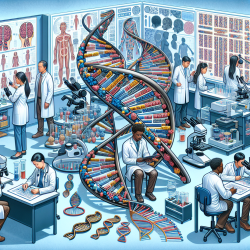The intersection of genetics and education is a burgeoning field that offers exciting opportunities for practitioners to enhance their skills and improve educational outcomes. A recent research paper titled "Counting the Genetic Ancestors from Source Populations in Members of an Admixed Population" provides valuable insights into genetic ancestry that can be applied in educational settings. This blog post explores how practitioners can leverage these insights to improve their practice and encourages further research in this area.
Understanding Genetic Ancestry in Admixed Populations
The study focuses on genetically admixed populations, where individuals possess genealogical and genetic ancestry from multiple source groups. By combining a mechanistic admixture model with a recombination model, the research counts genetic ancestors from source populations—those genealogical ancestors who contribute to the genome of modern admixed individuals. This approach provides a deeper understanding of how genetic contributions are distributed across generations.
Application in Educational Settings
For practitioners working with students from diverse backgrounds, understanding genetic ancestry can offer insights into cultural heritage and identity. This knowledge can be used to create more inclusive and culturally responsive educational environments. By acknowledging the diverse genetic backgrounds of students, educators can tailor their teaching methods to better meet the needs of each individual.
- Cultural Awareness: Understanding the genetic makeup of students can help educators appreciate cultural differences and foster an inclusive classroom environment.
- Personalized Learning: Insights into genetic ancestry can inform personalized learning plans that respect each student's unique background.
- Family Engagement: Educators can use genetic insights to engage families in meaningful discussions about heritage and identity, strengthening school-family partnerships.
The Importance of Further Research
This study highlights the potential for further research into the applications of genetic ancestry in education. Practitioners are encouraged to explore how these insights can be integrated into their practice to enhance learning outcomes. Continued research will not only deepen our understanding of genetic ancestry but also provide new tools and strategies for educators.
Encouraging Practitioner Research
Practitioners are encouraged to conduct their own research or collaborate with researchers to explore the implications of genetic ancestry in educational settings. By doing so, they can contribute to a growing body of knowledge that supports diverse learners and promotes equity in education.
Counting the Genetic Ancestors from Source Populations in Members of an Admixed Population










